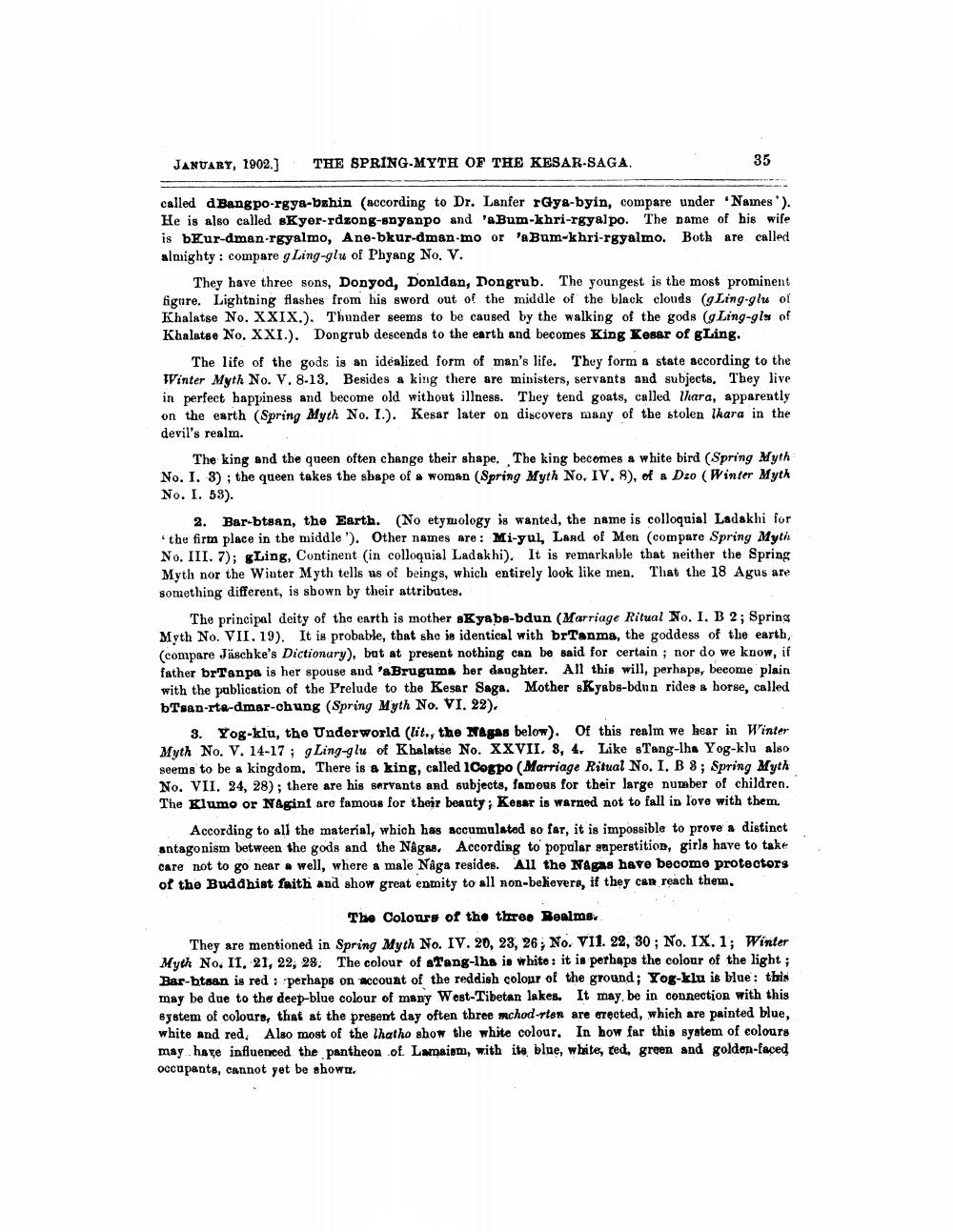________________
JANUARY, 1902.)
THE SPRING-MYTH OF THE KESAR-SAGA.
35
called d Bangpo-rgya-bzhin (according to Dr. Lanfer rGya-byin, compare under 'Names'). He is also called skyer-rdzong-enyanpo and 'a Bum-khri-rgyalpo. The name of his wife is bŁur-dman-rgyalmo, Ane-bkur-dman mo or 'a Bum-khri-rgyalmo. Both are called almighty: compare g Ling-glu of Phyang No. V.
They have three sons, Donyod, Donldan, Dongrub. The youngest is the most prominent figure. Lightning flashes from his sword out of the middle of the black clouds (Ling-glu of Khalatse No. XXIX.). Thunder seems to be caused by the walking of the gods (g Ling-gis of Khalatse No. XXI.). Dongrub descends to the earth and becomes King Kesar of gLing.
The life of the gods is an idealized form of man's life. They form a state according to the Vinter Myth No. V.8.13. Besides a king there are ministers, servants and subjects. They live in perfect happiness and become old without illness. They tend goats, called thara, apparently on the earth (Spring Myth No. 1.). Kesar later on discovers many of the stolen lkara in the devil's realm.
The king and the queen often change their shape. The king becomes a white bird (Spring Myth No. I. 3); the queen takes the shape of a woman (Spring Myth No, IV. ), of a Dzo (Winter Myth No. I. 53).
2. Bar-btsan, the Earth. (No etymology is wanted, the name is colloquial Ladakhi for the firm place in the middle"). Other names are: Mi-yul, Land of Men (compare Spring Myth No. III. 7); gLing, Continent in colloquial Ladakhi). It is remarkable that neither the Spring Myth nor the Winter Myth tells us of beings, which entirely look like men. That the 18 Agus are something different, is sbown by their attributes.
The principal deity of the earth is mother sKyabs-bdun (Marriage Ritual No. I. B 2; Spring Myth No. VII. 19). It is probable, that she is identical with brTanma, the goddess of the earth, compare Jäschke's Dictionary), but at present nothing can be said for certain ; nor do we know, if father brTanpa is her spouse and 'Brugums ber daughter. All this will, perhaps, become plain with the publication of the Prelude to the Kesar Saga. Mother Kyabs-bdun rides a horse, called bTsan-rta-dmar-chung (Spring Myth No. VI. 22).
3. Yog-klu, the Underworld (lit., the Nigas below). Of this realm we hear in Winter Myth No. V. 14-17; g Ling-glu of Khalatse No. XXVII, 8, 4. Like BTang-Iha Yog-klu also seems to be a kingdom. There is a king, called 1Cogpo (Marriage Ritual No. I. B 8; Spring Myth No. VII. 24, 28); there are his servants and subjects, famous for their large number of children. The Klumo or Nagint are famous for their beauty; Kesar is warned not to fall in love with them.
According to all the material, which has accumulated so far, it is impossible to prove a distinct antagonism between the gods and the Nagas. According to popular superstition, girls have to take care not to go near a well, where a male Nâga resides. All the Nagas have become protectors of the Buddhist faith and show great enmity to all non-believers, if they can reach them.
The Colours of the three Realms. They are mentioned in Spring Myth No. IV. 20, 23, 26; No. V11. 22, 30; No. IX. 1; Winter Myth No. II, 21, 22, 28. The colour of aTang-Iba is white: it is perhaps the colour of the light; Bar-btaan is red perhaps on account of the reddish colour of the ground; Yog-klu is blue: this may be due to the deep-blue colour of many West-Tibetan lakes. It may be in connection with this Bystem of colours, that at the present day often three mchod-ston are erected, which are painted blue, white and red. Also most of the Thatho show the white colour. In how far this system of colours may have influenced the pantheon of Lwdaism, with its blue, white, red, green and golden-faced occupante, cannot yet be shower.




